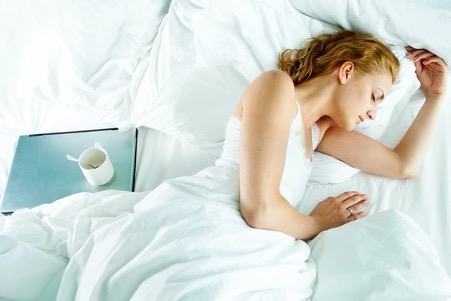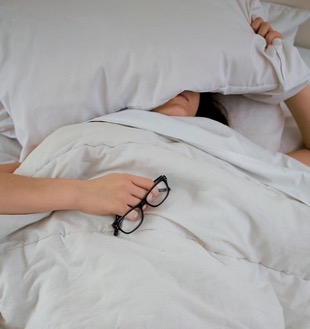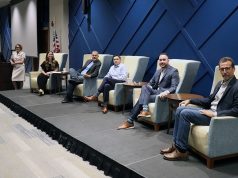Dr. David Zagzag is a Professor of Pathology and Neurosurgery, and also the Chief of the Division of Neurology at NYU Langone Health. Below Dr. David Zagzag discusses the onset of what many people are referring to as “COVID-somnia”.
The COVID-19 pandemic may have triggered another global health crisis—but unfortunately, it is often undiagnosed, untreated, and even brushed off completely. It is called COVID-somnia: an increase of sleep problems caused by prolonged stress, anxiety, and other unique realities triggered by the pandemic.
Psychologists first began observing COVID-somnia in 2020, and cases are on the rise. The Sleep Foundation reports that four out of 10 people experienced sleep problems after the pandemic. Another report says insomnia rates increased by up to 20% in the United Kingdom, Italy, Greece, and China. Dr. David Zagzag further explains that web searches for insomnia surged after lockdowns were announced.
What is COVID-somnia, and why is it serious?
Dr. David Zagzag explains that even before the pandemic, millions of people have already experienced some form of insomnia or sleep disorder. Symptoms include:
- Difficulty falling asleep or staying asleep
- Poor sleep quality
- Nightmares
- Sleep insufficiency, or getting less than 7 hours of sleep a day
However, the pandemic caused more people to experience sleeplessness, and worsened the symptoms of those who already had it. It reached a point that losing sleep seemed to be “The New Normal” – prompting many to brush aside the symptoms.
But COVID-somnia is a serious issue says Dr. David Zagzag. Even before the pandemic, experts have urged to classify insufficient sleep syndrome as a major non-communicable disease. It is linked to 7 out of 15 leading causes of death, and its impact on productivity also hints at its impact on economy.
Factors that can trigger COVID-somnia
Dr. David Zagzag explains that even people who never experienced insomnia suddenly found themselves awake and anxious at 3 am.
Disrupted routines and lack of schedule
Normally, our body clock is ruled by routines and natural circadian rhythms. We are used to going to work and school during the day, and then going home to rest at night. Over the years, certain habits signal the brain that it’s time to unwind and get ready for sleep—whether it’s the commute home or changing into pajamas.
The lockdowns, and the shift towards remote work, disrupted those routines. Most people began working longer and irregular hours and had greater difficulty drawing boundaries between “productive time” and “personal time.” Even after going to bed, people still found themselves thinking about work, or feeling guilty that they weren’t working.
Combine that with the fact that most people in remote work environments lost all concept of having a schedule. Work was performed at will, entertainment consumed at will – even meals which would normally be confined to certain times as to fit in with the work commute, designated breaks, etc., would be taken more spontaneously. All this “lack of schedule” wreaks havoc on normal energy and sleep patterns.
Dr. David Zagzag explains that without clearcut routines and rules, the brain and body lost important sleep cues.
Less outdoor time
The sun is the body’s natural “time giver” or zeitgeber and cues our bodies to stay awake or go to sleep. Even that short amount of time walking to work in the morning cues the internal clock.
Quarantine changed that. Unless one had the luxury of a back yard or large windows, isolation at home often meant getting very little natural sunlight according to Dr. David Zagzag. Combined with a more flexible workday that allowed for afternoon naps or late-night meetings, it was only a matter of time for the natural circadian rhythm to be completely disrupted.
Prolonged stress from being “FED UP”
Stress and anxiety releases hormones that make the body more energetic and alert. Unfortunately, the pandemic created several stressors, summarized in the mnemonic FED UP:
- (F)inancial stress from unemployment or paycheck cuts
- (E)motional stress from worrying about the future or the health of loved ones
- (D)istance from friends, family and other social support systems
- (U)npredictability from new COVID-19 variants, changing government policies, and uncertain economic forecasts
- (P)rofessional and (P)ersonal concerns, or how the pandemic affected one’s career or educational opportunities, relationships, hobbies and interests
Higher media consumption
There are many studies that link electronics and online media consumption with insomnia.
On the physical level, blue light emitted by phones and tablets confuses the body’s circadian rhythm.
On the mental level, spending time on social media or watching a show before going to bed floods us with stimuli that we continue to process even after putting down the phone or tablet.
Dr. David Zagzag reports that there are also studies that link social media with feelings of anxiety and depression—which contribute to sleep disorders as a whole.
Typically, the simple “cure” would be to spend less time online. However, the pandemic forced people to do almost everything through the Internet: work, social interaction, entertainment, shopping, banking, and more.
Less exercise or physical activity
Not surprisingly, many people reported getting less exercise and physical activity during the pandemic. It was impossible to go to the gym or take a walk after dinner; even light, everyday activity like walking to the train station was reduced to walking between the refrigerator and the laptop.
So Dr. David Zagzag says that for most people who were stuck at home, the pandemic meant being mentally exhausted yet physically inactive—or “being wired but not tired.” That alone could already lead to restless energy during bedtime, and an increased risk for COVID-insomnia.
Increased caffeine and alcohol intake
A drawback to the “work anytime” aspect of WFM arrangements is that often people will break up the workday into chunks of hours, again, not on any fixed schedule. This means that workers will attempt to catch up tasks at the end of the day and in order to do so, may get into the habit of pounding energy drinks or coffee as late as 7PM or 8PM, if not later. Trying to come down off that late in the day caffeine spike and having a good eight hours of uninterrupted sleep is not so easy.
Likewise, the WFM model means people of free to consume alcoholic drinks during the workday. Depression and anxiety from isolation have also contributed to increased alcohol consumption, which in turn disrupts healthy sleep patterns.
Who has higher risk for COVID-somnia?
While anyone can experience sleep problems during the pandemic, there are risk groups who are more likely to be affected or experience more severe symptoms. Dr. David Zagzag note that The Sleep Foundation names some of them:
- People who have COVID-19, or have had it before
- Frontliners and essential workers
- Caregivers
- Teenagers
- Elderly
- Women
- People of color or minority groups
Psychologists say that these groups are at risk for poor sleep patterns because they may be more vulnerable to the stress, anxiety or unpredictable outcomes brought on by the pandemic.
For example, frontliners and caregivers have to deal with longer working hours, anxiety from risk of exposure, and post-traumatic stress disorder.
Adolescents are at the developmental stage when they need to have positive interactions with peers and people outside of their family.
Working women may have to carry greater burdens at home, as they adjust to remote work while being expected to bear the brunt of childcare and housework.
Managing COVID-somnia
Like all medical conditions, recognizing COVID-somnia is the first step to preventing, treating, and managing it so it doesn’t affect quality of life.
Dr. Zagzag recommends people incorporate the following points to improve sleep habits:
- Increase exercise and physical activities; especially outside if feasible. Start a new fitness routine today, block out the time required to keep on schedule.
- Set a regular wake up time. It doesn’t matter if you can start work “whenever”; your body needs to understand when it’s time to be awake and when to shut down for sleep.
- No caffeine after 2PM. Schedule your workouts and WFM routine accordingly.
- Stop alcohol consumption 3 hours before bedtime.
Dr. David Zagzag explains that positive steps include actively taking care of mental health and well-being, getting enough exercise, and creating boundaries and routines at home. It’s also important to treat the root cause: if your sleeplessness is a symptom of chronic anxiety and depression, then seek counseling or other alternative therapies to get it under control.
Treating COVID-somnia is not just about getting better sleep but protecting one’s health and getting a better quality of life.









